Make Lead Magnets in 7 easy Steps:
Building an engaged audience is key for any blogger, YouTuber, or social media creator, and a great lead magnet is one of the most effective ways to do it. (💡In a hurry? Read the rapid summary version of this information, the link is just below image ⬇️)
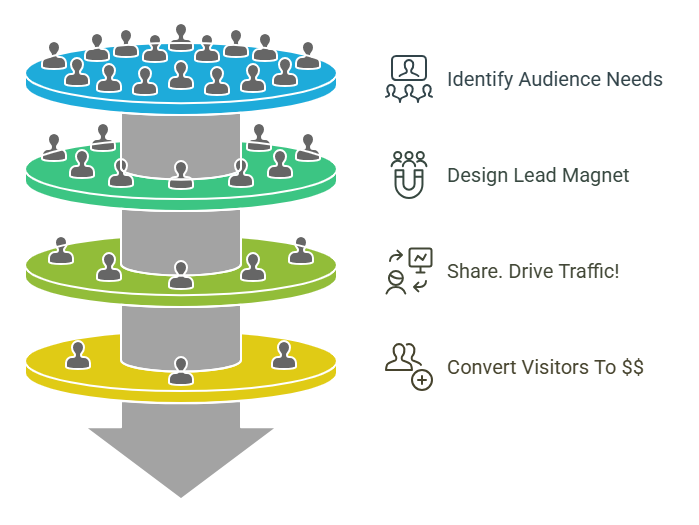
💡In a hurry? To read the rapid summary version Click Here.
A lead magnet is a free piece of value you offer your audience in exchange for their contact info (usually an email).
It could be an ebook, checklist, template, exclusive video, etc. - something your audience really wants.
Why go through the trouble? Because email remains one of the most powerful assets for online creators.
- "Email marketing has a return on investment (ROI) of between $36 and $42 for every dollar you spend." - Neil Patel
The best way to get more email subscribers and build a relationship with them is through lead magnets.
A compelling lead magnet attracts your followers, turns them into email subscribers, and starts building trust by helping them right away.
This ultimate guide will walk you through a step-by-step process to create a high-converting lead magnet. We’ll keep it general (no matter your niche or platform) and include real examples of successful lead magnets.
Follow these steps, and you’ll be on your way to converting more visitors and viewers into loyal subscribers and customers.
Step 1:
Know Your Audience and Pinpoint Their Needs
The first step to a perfect lead magnet is deeply understanding your target audience and their pain points. You need to offer something they truly crave or a solution to a problem that’s been nagging them.
If your lead magnet doesn’t address a real need or interest, it won’t attract sign-ups.
Identify their challenges: Ask yourself, who is my content for, and what problem can I help them solve? Consider surveying your audience or engaging with them directly.
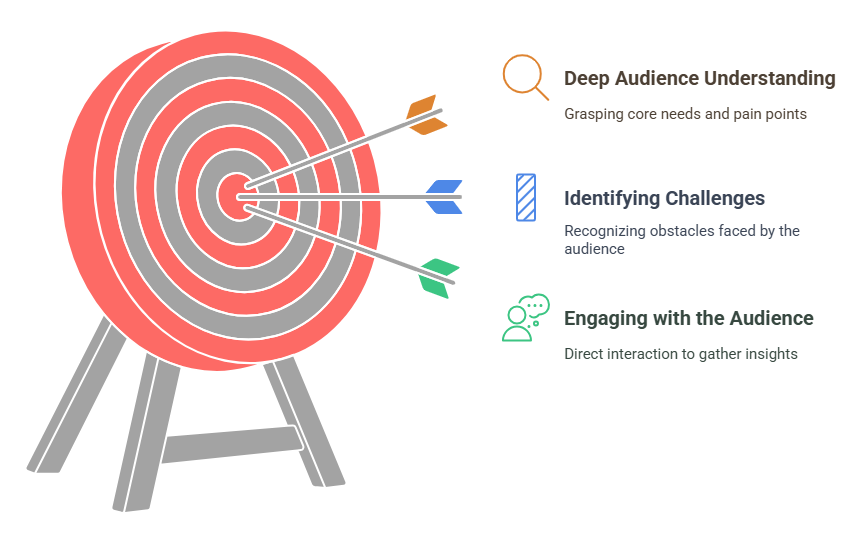
For example, run a quick poll or ask questions like:
What’s your biggest struggle with [your niche/topic]?
Example: “What’s your biggest struggle with growing your YouTube channel?”If you could learn one thing that would make [desired outcome] easier, what would it be?
Example: “If you could learn one thing to make content creation faster, what would it be?”What’s one tool, template, or resource you wish you had right now to help with [pain point]?
Example: “What’s one checklist or template that would make blogging easier for you?”Have you tried solving [problem] before? If so, what didn’t work for you?
Example: “Have you tried growing an email list before? If so, what stopped you from succeeding?”What’s your goal with [topic] in the next 6 months, and what’s stopping you from achieving it?
Example: “What’s your goal with affiliate marketing in the next 6 months, and what’s holding you back?”
Tools like Google Forms or Twitter polls (or YouTube community posts) can help collect this feedback.
Listen on social media and forums: Pay attention to comments, Facebook Groups, subreddits, or other communities where your audience hangs out. What questions come up repeatedly?
Common frustrations or “I wish I knew how to…” statements are gold clues for a potential lead magnet topic.
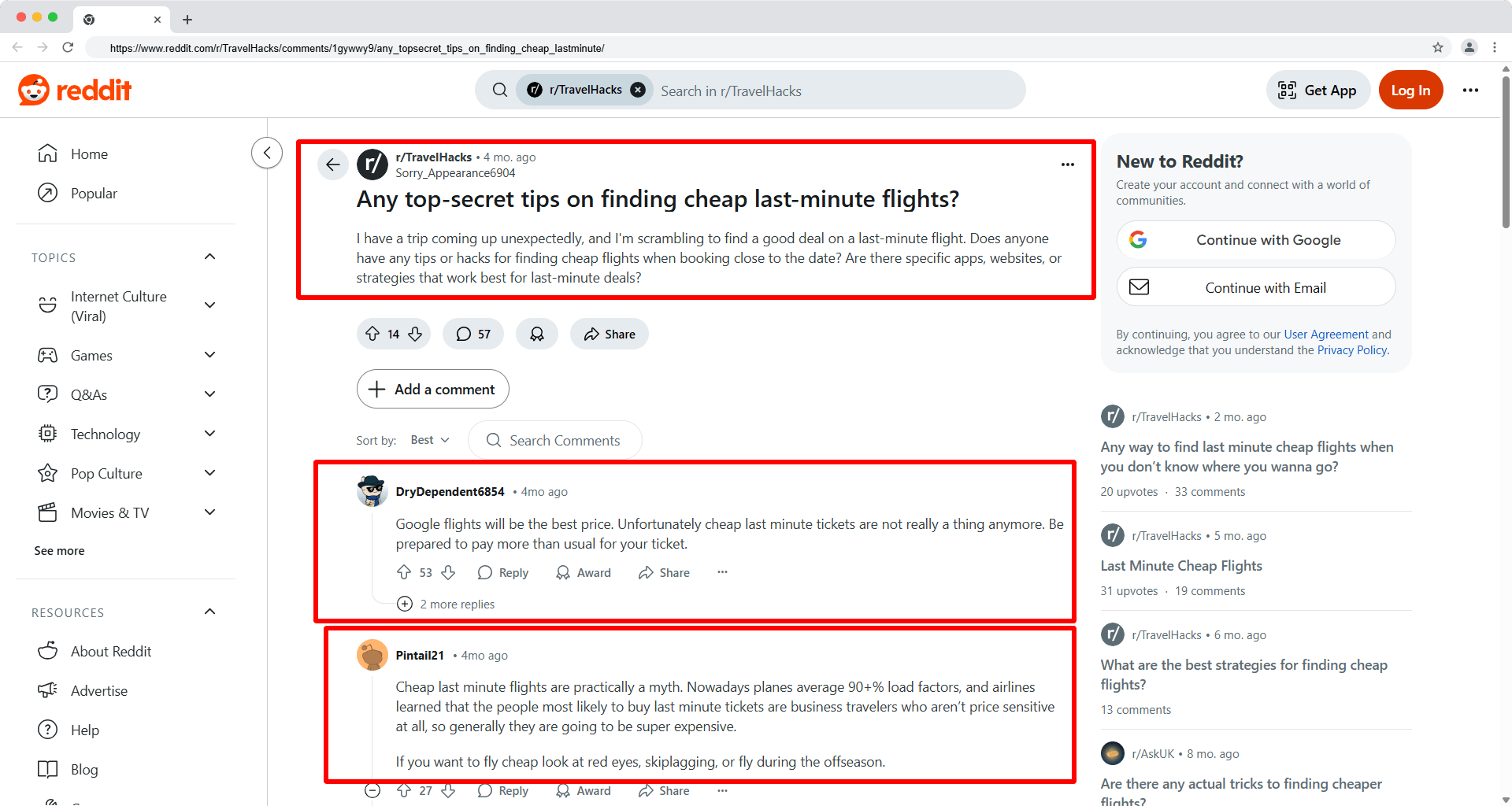
Research competitors and industry FAQs: Look at reviews or comments on competitors’ content/products for recurring complaints or needs.
Also, notice what your peers are offering as lead magnets – it can hint at what the audience values (though you’ll want to put your own unique spin on it).
You should have a clear idea of a specific problem to solve or desire to fulfill.
For instance, a travel vlogger might discover their viewers struggle with planning low-budget trips, or an Instagram food blogger might find followers who want healthy recipes for busy schedules.
⚠️ Knowing this ensures your lead magnet will hit a bullseye. ⚠️
Step 2:
Craft an Irresistible Value Proposition
Now that you know your audience’s big need, translate that into a promise of value.
In other words, why should someone give you their email? What exactly will they get, and how will it help them? This is your lead magnet’s value proposition – essentially the hook that makes it irresistible.
Be specific and outcome-focused.
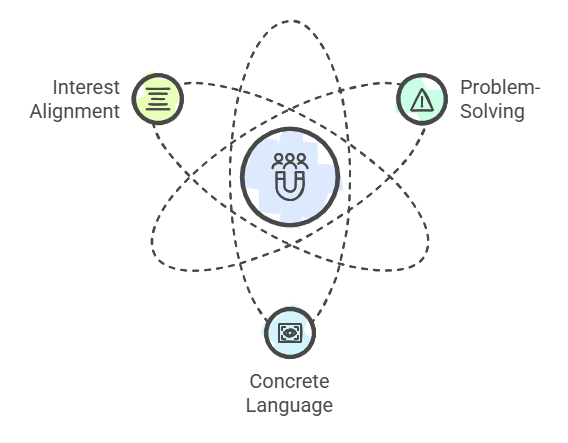
For example, don’t just offer “Tips for Photography”; offer “A 10-Minute Guide to Sharp Action Photos – Never Take Blurry Sports Pictures Again.”
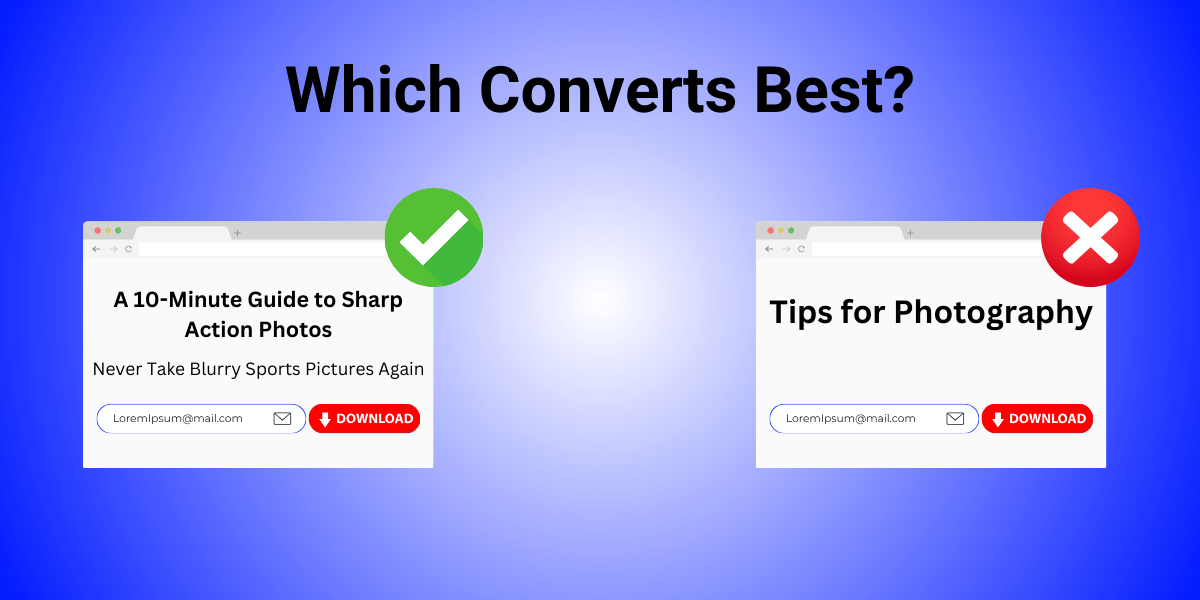
The more clearly you state the benefit, the more compelling it is. Tell your audience exactly what’s in it for them.
Solve a problem or give a quick win: If your audience struggles with something, promise to fix it. E.g., “Get my cheat sheet for writing viral blog titles – so you’ll never run out of catchy ideas.” Make it clear how your freebie makes their life easier or better.
Use concrete language: Instead of vague advice, hint at tangible results. For instance, “5 email templates to land sponsorships” is better than “sponsorship advice.” Numbers, specifics, or timeframes (“in 5 minutes,” “step-by-step”) help people picture the benefit.
Align with their interests: Frame it in terms of their goals. If onboarding new software users is a headache for them, you might say, “User Onboarding in 5 Minutes or Less – get new users saying ‘aha!’ faster”. Show you understand their need and offer a resource that meets it.
Take a moment to write a one-sentence elevator pitch for your lead magnet. It should highlight the specific benefit your audience gets.
Step 3:
Choose the Right Lead Magnet Format
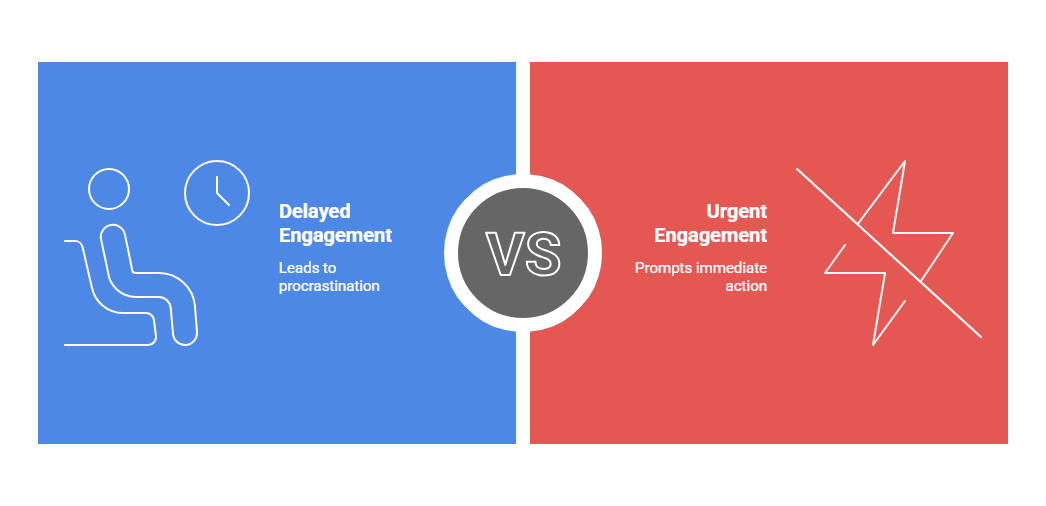
Choosing the format that best delivers your value (and that your audience prefers) can boost your conversion rate.
The format can make the difference between someone thinking, “I’ll check this later” and “I need this now!”
Here are some popular formats and when to use them:
Ebook or Guide: Great for topics where your audience wants a deep dive with lots of details or strategies. An ebook gives a comprehensive overview – perfect if your followers say they want all the info in one place. (Just be careful: keep it focused and easy to read, rather than a 200-page tome.)
Checklist or Cheat Sheet: Ideal for a busy audience that craves quick results. Checklists boil a complex task down to a simple list of steps. They’re fast to consume and super actionable (e.g., “Blog Post Launch Checklist” or “10-Step Morning Workout Routine”). People love them because they can implement them immediately.
Templates or Worksheets: If you can save your audience time, templates are gold. This could be a fill-in-the-blank worksheet, a content calendar template, a preset filters pack for photos, etc. It gives a ready-made solution they can plug and play. Templates are practical – they skip the setup and let users get straight to the results.
Resource List or ToolKit: A curated list of tools, apps, or resources related to your niche (for example, “Top 50 Hashtags for Food Bloggers” or “Video Editing Gear List for YouTubers”). It caters to people looking for recommendations without doing the research themselves.
Quiz or Assessment: Interactive and fun – quizzes can both engage your audience and give them personalized results. For example, a fitness coach might offer “What’s Your Ideal Workout Style?” quiz that emails a custom workout plan based on the result. Quizzes work well to entertain and educate at the same time.
Video Tutorial or Webinar: If you’re great on camera (hello, YouTubers!), a short exclusive video or on-demand webinar can be a fantastic lead magnet. It adds a personal touch and can convey complex info more engagingly. For instance, a live or recorded webinar on “How to Monetize Your Instagram in 30 Days” with a Q&A segment can attract lots of sign-ups.
Email Course or Challenge: A series of quick lessons delivered by email (e.g., a 5-day challenge) keeps people engaged over several days. This format is effective for nurturing and building a habit (like a “5-Day Photography Bootcamp” – one tip per day, etc.).
Remember, the best format depends on what your audience finds most convenient and valuable.
A busy professional might prefer a one-page cheat sheet, whereas a newbie might value a 30-minute how-to video.
Also, choose a format you can create efficiently with quality.
Don’t force yourself to make a video if you have zero video skills (in that case, a PDF guide might be easier, or vice versa).
Finally, ensure the format matches the depth of information: a simple problem (like needing a checklist) doesn’t require a 50-page ebook, and a one-page PDF might not solve a complex problem.
Step 4:
Create Valuable and Actionable Content
Now it’s time to build the lead magnet itself – create the content and make it truly valuable. The quality of your lead magnet reflects on you, so make it count!
Here are key tips for crafting content that converts:
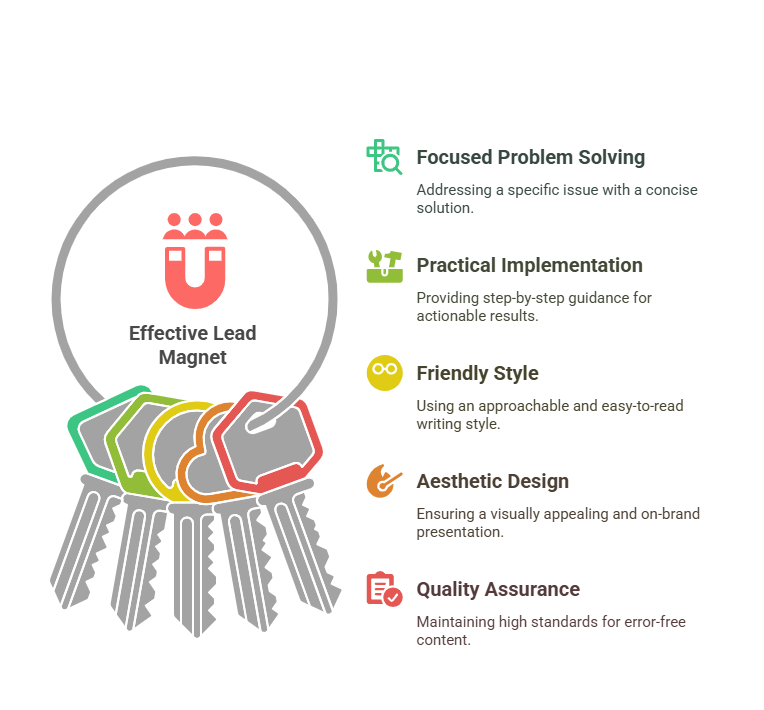
Solve a specific problem (and keep it focused): The best lead magnets don’t try to do everything. Remember, the best lead magnets are short, not long.
Give your audience snacks. Focus on one quick win or topic. If your magnet is an ebook, it might be a concise 10-page guide tackling one challenge really well, rather than a broad textbook.
Make it ultra-practical: Advice alone isn’t enough – don’t stop at “what to do,” but also give the “how to do it”. Provide step-by-step instructions, examples, or worksheets.
For instance, if your lead magnet is “How to Edit Videos Like a Pro,” include screenshots of editing settings or a sample project file. The user should feel like, “Wow, I have exactly what I need to take action.”
Use a friendly, easy-to-read style: This isn’t the place for academic jargon or filler fluff. Write as if you’re coaching a friend. Use short sections, clear headings, and bullet points so that even someone skimming can get the gist.
Design matters: You don’t need to be a pro designer but do make it look nice and on-brand. A clean layout, your branding (colors/font/logo), and maybe a few images go a long way to increase perceived value. Many creators use tools like Canva to quickly design PDFs, eBooks covers, or infographic-style checklists. Templates from Canva or similar platforms can give your lead magnet a polished look in minutes.
Double-check for quality: Since this might be the first piece of content a new subscriber sees from you, ensure it’s error-free. Check spelling, make sure all the links or downloads work, and that the information is accurate. A sloppy lead magnet can hurt the trust you’re trying to build.
Whether it’s a PDF, a video file, an email series, or something else, it should deliver on the promise you made in Step 2 in a way that’s easy to consume and act on.
I prefer using LeadCreator.ai because it allows you to create, share, track, and maintain your lead magnets from one dashboard.
Step 5:
Set Up a Landing Page or Opt-In Form
With a fantastic lead magnet in hand, you need a way for people to actually sign up and get it. This usually means creating a landing page or opt-in form that advertises your lead magnet and collects emails.
In some cases, this is a dedicated landing page; in others, it could be a pop-up form on your website or a sign-up box embedded in a blog post.
No matter the format, some best practices for your lead magnet opt-in page/form are:

Write a clear, compelling headline: This headline should reiterate the main benefit of your lead magnet. For example: “Free 5-Day Course to Double Your Instagram Followers” or “Download the Ultimate DIY Home Repair Checklist.”
Make it attention-grabbing and concise. It’s the first thing visitors see, so highlight what they get.
Bulleted benefit points: Below the headline, include 2-5 bullet points that spell out what’s inside or how it helps them. Think of these as the “selling points” for your free offer. If your magnet is an eBook, bullets might be like “Learn how to save 5 hours per week on editing,” “Discover the top 3 apps to automate your posts,” etc.
Keep them punchy and focused on outcomes.
Eye-catching call-to-action (CTA) button: Your sign-up button should stand out (bright color, large font) and have actionable text. Instead of a boring “Submit,” use text like “Get the Free Guide” or “Send Me the Checklist.” Make the button big and obvious – something people can’t miss.
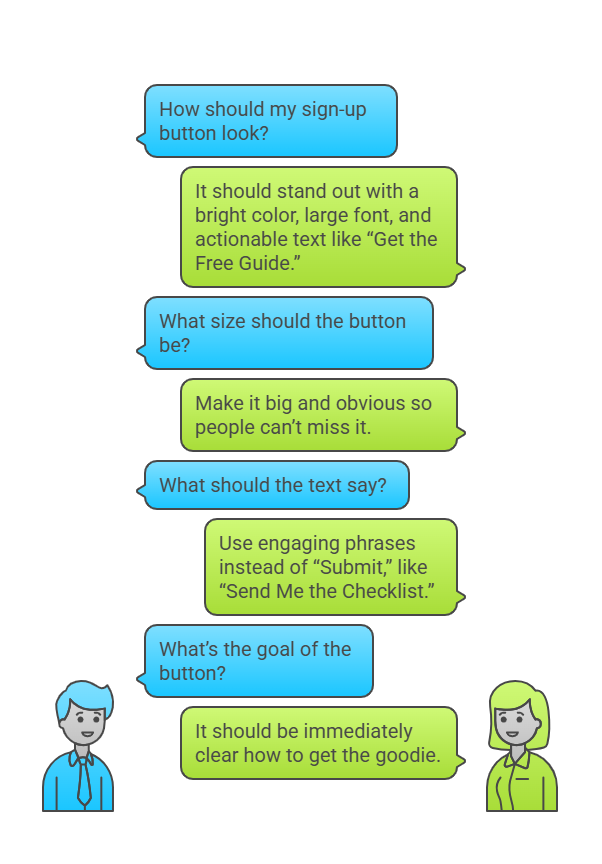
It should be immediately clear how to get the goodie.
Keep the form simple: Don’t ask for too much info. Usually name and email are enough. The more fields you ask people to fill, the more friction (and the fewer sign-ups). You can always gather more info later as needed. For now, make it dead-simple to join.
Match your branding: If you have a certain style on your blog or channel, carry that over to the landing page or form.
Use an image of your lead magnet if possible (e.g., 3D eBook cover, or a screenshot of a worksheet) to make it tangible.
A clean, professional-looking form or page can increase trust. You do not need to custom-code anything fancy – many email services and landing page builders have templates you can tweak easily to make a nice-looking opt-in page.
Your landing page or form is where visitors become subscribers, so it’s pivotal. Often, simple works best.
A high-converting landing page doesn’t need to be long or complex – sometimes just a headline, a brief description or a few bullet points, and a sign-up form is enough.
Make sure it’s mobile-friendly, many people will click your link from a phone, especially social media traffic.
If you’re a YouTuber or primarily on social media, you might not have a full website for a landing page – in that case, use a service LeadCreator.ai to create a quick landing page, or use your channel’s features (community tab, etc.).
The principle remains: have a dedicated place to send people where they can sign up for your lead magnet easily.
Step 6:
Deliver the Lead Magnet (Follow-Up Email)
When someone signs up, you need to deliver on your promise instantly. Typically, this means sending a follow-up email that contains a download link or access instructions for your lead magnet.
If you are using LeadCreator.ai this is done automatically because they get access immediately, without needing to check their email.
This is possible because LeadCreator uses a LIVE spam filter that blocks all spam emails on the form as it's entered.
But, if you are using a traditional method where you deliver your lead magnet over email...
Here’s how to make that delivery smooth and satisfying:
Send a welcome/thank you email: As soon as they opt in, your email service should send an automatic email to the new subscriber. Start by thanking them for joining or confirming their download.
For example: “Thanks for signing up! Your free guide is attached below.” Being polite and appreciative sets a positive tone.
Make the download super obvious: Don’t hide the goods behind too much text. Include a big, clear link or button near the top of the email for them to get the lead magnet.
For instance: “👉 Download Your Recipe Ebook” as a big button. People shouldn’t have to hunt for how to actually get what they signed up for. If it’s a PDF, you might attach it or link to it. If it’s a video, give the direct link. Make it foolproof.
Restate the value (briefly): In one or two lines, remind them what they’re getting and how it’ll help. e.g., “Inside this ebook, you’ll find 20 easy recipes under 30 minutes. I hope it helps make your weeknight dinners a breeze!”
This reinforces that they made a good choice signing up.
Optional next steps: You might use this email to suggest what to do after they consume the magnet. For example, “After you’ve tried some recipes, hit reply and let me know your favorite!” or “Stay tuned, because I’ll send more Instagram growth tips your way.”
But don’t overload this first email. The main goal is deliver the promised content and set a friendly tone.
No hard sells here: Avoid turning the very first email into a sales pitch. You can certainly have a call-to-action if appropriate (maybe you have a related course or a community they can join), but keep the focus on the free resource they expected. You’re building trust at this stage.
There will be time later to pitch products or services once you’ve provided value upfront.
Keep the delivery email short and sweet. Thank them, give the link, and maybe tease what’s coming next — no more, no less.
Also, ensure the email comes from a real-looking address (ideally your name or brand, not some “no-reply” address) and has a personable tone.
This way, the subscriber feels like they just got an email from a helpful friend, not a faceless marketing system.
Step 7:
Promote Your Lead Magnet Everywhere
You’ve done all the hard work to create and set it up; now you need to drive people to it.
Promotion is critical – a lead magnet won’t generate leads if nobody knows about it! Here’s how to spread the word and maximize sign-ups across various platforms:
On your blog or website: Mention your lead magnet in high-traffic areas. For bloggers, this means embedding signup forms in relevant blog posts (especially those getting good organic traffic), adding a prominent banner or slide-in on your homepage, or using a timed pop-up.
Just keep the user experience in mind – a polite pop-up after a reader has been on the page for a bit tends to work better than an instant, in-your-face popup. You can also create a top bar or a sidebar widget that advertises the freebie on every page.
In YouTube videos: If you’re a YouTuber, promote your lead magnet during your videos. A pro tip is to mention it early on in the video when engagement is highest (e.g., “Before we dive in, I’ve got a free guide on [topic] for you – link in the description!”).

Add the link in the video description, and use YouTube cards or end screens to remind viewers. Some creators even integrate the opt-in form into the video content. For example, one photography YouTuber talks directly to the camera encouraging viewers to get his free guide, and displays a call-to-action graphic on screen with the offer.
On social media: Leverage all your platforms – Twitter/X, Instagram, Facebook, LinkedIn, TikTok, wherever you have an audience. Post about your new free resource with an eye-catching graphic or short teaser video. On Instagram, for example, you could create a Story Highlight for the lead magnet, or mention “link in bio to get my free [guide/etc].”
On platforms like LinkedIn or Facebook, you might write a short post addressing the pain point and offering the solution via your lead magnet. Pin these posts where possible (Twitter pinned tweet, pinned Facebook post, etc.) so that anyone visiting your profile sees it first. Also, update your bio links: make sure the URL in your Instagram/Twitter bio or Linktree leads people straight to the landing page.
Email your existing list: If you already have some subscribers but are launching a new lead magnet (or haven’t promoted an old one in a while), let them know too! It might seem strange (“why promote a freebie to people who are already on the list?”), but your current subscribers might share it with friends who have similar interests, especially if you encourage them.
Plus, it provides additional value to your loyal followers.
Partnerships and collaborations: Consider doing a swap or shout-out with a fellow creator who targets a similar audience (but isn’t a direct competitor). For instance, you mention each other’s lead magnets in your newsletters or videos. This can expose your free offer to a whole new audience. Make sure it’s mutually beneficial and genuine.
Paid promotion: If you have some budget, running targeted ads (Facebook/Instagram ads, YouTube pre-roll, etc.) to your lead magnet landing page can accelerate list growth. Just keep an eye on cost per lead – you want to ensure it’s worth it. Often, creators focus on organic promotion first (which is free) and use paid ads later once they know the lead magnet converts well.
The key is to mention your lead magnet regularly and in relevant contexts. Don’t just throw up one tweet and call it a day.
Work it into your content schedule: for example, at the end of each blog post you might have a little bio box or section “Enjoyed this? Get my free [resource] to dive deeper.”
On YouTube, verbally remind viewers and point them to the description link. On social media, cycle through promotional posts or stories especially when you have a surge of new followers.
Think of every avenue: your email signature could even include a small call-out, “Grab my free ___ here.” If you’re interviewed on a podcast or doing a guest blog, mention your lead magnet as a free gift for the audience.
The more (tastefully) you promote it, the more subscribers you’ll gain.
Real-Life Examples of Successful Lead Magnets
To wrap up, let’s look at a few real-world examples where creators and businesses have hit the bullseye with lead magnets – and the results they achieved:
Brian Dean’s Content Upgrade (Backlinko): Brian Dean, a well-known blogger in the SEO space, once added a simple checklist PDF as a “content upgrade” to one of his blog posts – and saw a staggering increase in conversions. By offering a highly relevant bonus (tailored to the blog topic) in exchange for email sign-ups, he raised his conversion rate from about 0.5% to 4.8% – that’s a 785% jump in one day.
This case, despite being many years old, shows the power of giving exactly what readers want at the right moment. Instead of a generic “subscribe to my newsletter,” he offered something ultra-specific and immediately useful, and people responded with enthusiasm.
GetLeadForms Blog – Doubling Conversions with a Targeted Magnet: In a case study by a software company, a generic newsletter sign-up was underperforming (only a 0.55% conversion rate). They decided to add a targeted lead magnet, a “25-point checklist” content upgrade, to their highest-traffic blog post.
The result?
The conversion rate doubled overnight (from 0.55% to 1.1%), and the email sign-ups started rolling in. The content upgrade spoke directly to what readers of that post were interested in (a checklist to get more jobs on a gig platform), whereas a bland “sign up for updates” wasn’t enticing enough.
This example underlines how a little extra value can dramatically boost your list growth.
Minimalist Baker’s Recipe E-Book: Minimalist Baker, a popular food blog, offers a free 49-page recipe eBook (“Fan Favorites”) to email subscribers. This lead magnet aligns perfectly with what their visitors want.
It’s promoted via a pop-up on the site, ensuring nearly every visitor sees the offer. This free cookbook has helped them rapidly grow a massive email list of food enthusiasts, which in turn drives traffic back to their site whenever they email out new recipes. It’s a textbook example of knowing your audience (food lovers), giving them high-value content (a beautifully designed recipe collection) and reaping the rewards in subscriber growth and loyalty.
Each of these examples shares a common theme: the lead magnet was highly relevant and valuable to the target audience. They weren’t random PDFs or outdated whitepapers; they were specific, timely, and solved a real need or desire.
As you create your own, aim for that level of relevance and value.
It’s better to have one killer lead magnet that converts like crazy, than half a dozen mediocre ones that people shrug at.
Conclusion & Next Steps
Creating the perfect lead magnet might take some effort, but it’s one of the smartest investments of time you can make in building your online presence. To recap, you learned to:
Identify your audience’s pain point and craft a solution they truly want.
Offer a clear value proposition that excites people (make it an irresistible offer).
Choose a format that fits the content and your audience’s preference (ebook, checklist, video, etc.).
Create the content with quality and usefulness in mind – focused, actionable, and easy to consume.
Set up a landing page/form that communicates the offer and makes it simple to sign up.
Deliver the goods promptly with a friendly email, and maybe start nurturing your new leads.
Promote it everywhere relevant to draw in as many targeted subscribers as possible.
As a blogger, YouTuber, or social media creator, your email list is your direct line to your biggest fans. A great lead magnet is like the welcome mat that invites them in.
It can work for you 24/7 – new people discovering your content can be converted into email subscribers every day without you manually doing anything, once it’s all set up. That means your list (and your influence) grows exponentially over time.
One final tip: test and iterate.
Pay attention to your conversion rates. If 1,000 people see your lead magnet page but only 5 sign up, something might be off – perhaps the offer isn’t clear enough, or maybe you need a more enticing format or headline.
Don’t be afraid to tweak your copy, try a different graphic, or even experiment with a different lead magnet if the first one isn’t hitting the mark.
On the flip side, if you notice one content upgrade or freebie is performing extremely well, you might replicate that style or topic in future magnets.
You now have all the building blocks to create a high-converting lead magnet. So start brainstorming what your perfect lead magnet could be.
Once you launch it, you’ll be on your way to growing your email list, increasing engagement, and ultimately, expanding the reach and success of your personal brand or business.
Happy list-building – and may your new subscribers turn into longtime fans!
If you want a simple way to create, share, and manage your lead magnets (without messing around with a bunch of tools), I use LeadCreator.ai.
It lets you build your opt-in page, deliver your freebie, and track sign-ups — all in one place. Super handy, especially if you just want to get it done and start growing your list.
